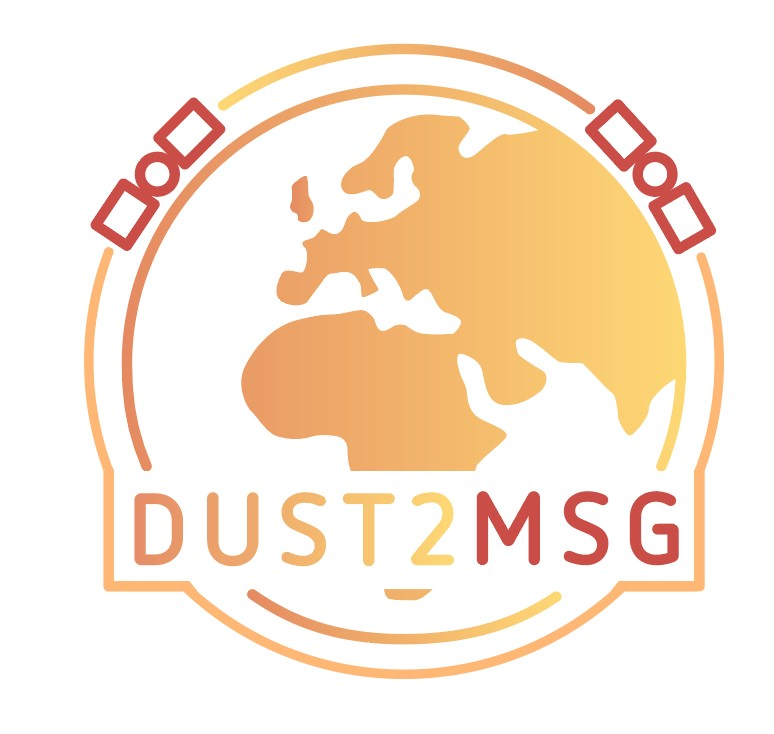About DUST2MSG
Sand and dust storms are extreme and rapidly evolving meteorological phenomena that generate significant amounts of mineral particles in the atmosphere. They play a significant role in different aspects of weather, climate and atmospheric chemistry and represent a serious hazard for life, health, property, environment and economy.
The objective of the DUST2MSG project is to derive an hourly dust product from the Meteosat Zero Degree Service and Indian Ocean Data Coverage area with the latest version of the CISAR algorithm capable of retrieving aerosol and cloud properties over any types of surface. Retrieval of high aerosol load from space observation is challenging as is can easily be erroneous flagged as clouds. The CISAR algorithm (Govaerts and Luffarelli, 2018; Luffarelli and Govaerts, 2019) has been extended to the retrieval of cloud optical properties to overcome the need of an external cloud mask. After a so-called training period, the CISAR algorithm process all available satellite observations, i.e. both cloudy and cloud free sky. This algorithm has already been successfully applied for the joint retrieval of surface, aerosol and cloud properties over any types of surface from SEVIRI, SLSTR and PROBA-V data.
Luffarelli et al. (2016) have stressed the important daily variations of the aerosol Jacobian from SEVIRI observations resulting from the change in scattering angles. These changes represent the major challenge to be solved to derive a consistent hourly aerosol product from SEVIRI observations. As can be seen on Figure 1, most of Africa, Mediterranean Sea and Middle East are observed simultaneously by both SEVIRI instruments, i.e, with different scattering angles. Luffarelli and Govaerts (2019) have already demonstrated the capability of CISAR to be applied on different satellite data, but not simultaneously. The major scientific challenge of this project will be the simultaneous processing of two different satellite over the common area data with the CISAR algorithm. The elaboration of a consistent observation vector composed of two different radiometers has never been performed so far. It is a very important development milestone as it will pave the way to the simultaneous processing of observations acquires by various radiometers with the CISAR algorithm.
This project includes the following activities:
- Input Data Preparation. The purpose of the WP is to acquire all satellite and ancillary data needed for the generation of the hourly dust product and to project them in a consistent spatial and temporal grid. SEVIRI data will be harmonized using Rayference method developed over Libya-4 and used for the calibration correction of SLSTR. This activity is important to secure the radiometric consistency between two sensors. The SEVIRI data will finally be projected on a common grid.
- Algorithm adaptation. The CISAR algorithm and the GEDAP processing environment will be improved to be able to process simultaneously, i.e., as part of single observation vector, two satellite data. Currently CISAR and GEDAP are only capable of processing data acquired by a single instrument, where each pixel has the same spectral dimension and geometry of acquisition and illumination.
- Dust Product Generation. The GEDAP environment will be used for the generation of the hourly aerosol product. Dust information will be derived from that information. A minimum of four months selected during the dust season will be processed for 2019.
- Dust Product Evaluation. The generated product will be compared with respect to ground observation (AERONET), simulations (CAMS, SDS-WAS) and similar AEROSOL product derived from satellite observations (e.g., MODIS C6 aerosol product). The DUST2MSG product will be evaluated with respect to the CEOS requirements, separating the fine and coarse mode, the coarse mode being associated with dust. AERONET stations located in the common area will be used for the evaluation of the hourly resolution of the product.
Funding
DUST2MSG is funded by the European Space Agency (ESA) under Contract No. 4000121362/17/I-NB

